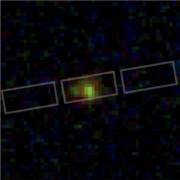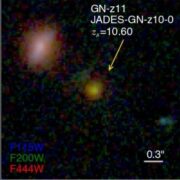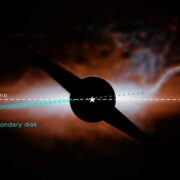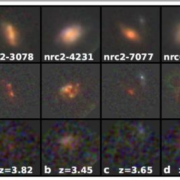An international team, led by the Centro de Astrobiología (CAB), CSIC-INTA, has discovered the most distant barred spiral galaxy similar to the Milky Way observed to date. The discovery, made possible thanks to the extraordinary capabilities of the James Webb Space Telescope, has been published in the Nature journal.
08-11-2023
We believed that barred spiral galaxies similar to our home galaxy, the Milky Way, could not be observed until the Universe reached half of its life, which is nowadays estimated to be around 13,800 million years. “Unexpectedly, this discovery reveals that galaxies that resemble our own existed already 11,700 million years ago, when the Universe had just 15% of its life”, stated Luca Costantin, a CSIC postdoctoral researcher at CAB in Madrid and principal author of the study.
Astrophysicists have been studying the structure of galaxies at different distances (i.e., at different epochs of the Universe’s life) trying to reconstruct the formation mechanisms and the evolution- ary history of our galaxy. In the nearby Universe, we observe that most of the massive spiral galaxies, like the Milky Way, show in their central region an elongated structure that resembles a bar. On the other hand, theoretical models predict that the physical and dynamical conditions in place in the early Universe prevent the formation of barred galaxies. Galactic bars play a funda- mental role in galaxy evolution, since are responsible for mixing chemical elements in the galaxy, which favors the birth of new stars (like the Sun).
“Galaxies did not always look like we see them around us today, since their structure and mass change throughout their lifetime. Thus, while Milky Way-like galaxies are common in the nearby Universe, we thought they were extremely rare in the past. At least, until today”, said Pablo G. Pérez González, an INTA’s senior researcher at CAB and second author of the study.
Up to date, our knowledge about the morphology of distant galaxies was based on observations conducted with the Hubble Space Telescope (HST), which revealed that these galaxies show highly irregular structures, possibly due to merging events. But, recent observations from the James Webb Space Telescope (JWST) have been revolutionizing our understanding of the early Universe, drawing a picture that challenges our previous knowledge.
“With JWST we have, for the first time, the technology to study the detailed morphology of very distant galaxies. This is essential to understand their history, opening the door to new scenarios about galaxy formation and evolution”, commented Cristina Cabello, a postdoctoral researcher at the Instituto de Física de Partículas y del Cosmos of the Universidad Complutense de Madrid (IPARCOS-UCM).
EMBARGO: Nature
END OF EMBARGO – Wednesday, 08 November 2023 @ 17:00 CET
(16:00 London Time)
(11:00 US Eastern Time)
Ctra. de Ajalvir km 4, 28850 Torrejón de Ardoz, Madrid, España tel.: 34 91520-6433 http://www.cab.inta-csic.es
Exploiting the superb capabilities of JWST, the team led by CAB has discovered the most distant galaxy similar to the Milky Way known to date. The spiral barred galaxy (labeled ceers-2112) is observed at a redshift of 3, that is, when the Universe was only 2,100 million years old, challenging our current understanding of galaxy evolution. The discovery and the detailed analysis have been published in the Nature journal.
“ceers-2112 can be considered a galaxy similar to the Milky Way, having a barred spiral struc- ture and a mass similar to our galaxy at that time of the Universe life”, explained Luca Costantin. “This discovery confirms that the evolution of this galaxy was dominated by baryons (the ordinary matter we are made of) and not by dark matter, despite its over-abundance, when the Universe had only 15% of its actual age”, added Jairo Méndez Abreu, a researcher at the Universidad de La Laguna.
The spiral barred nature of ceers-2112 has been identified thanks to deep multi-wavelength im- aging taken with the NIRCam instrument onboard JWST. The dataset was collected as part of the CEERS (Cosmic Evolution Early Release Science) program led by Steven L. Finkelstein (Uni- versity of Texas, USA), which has targeted a sky region in the direction of the Ursa Major and Boötes constellations. The study involved 33 researchers from 29 institutes in 8 countries. The bar structure has been detected thanks to various methods, e.g., modeling the galaxy light across wavelength or studying the spatial variation of the symmetric components (Fourier analysis).
About CAB
Centro de Astrobiología (CAB) is a joint research center of the National Institute of Aerospace Technology (INTA) and the National Research Council (CSIC) of Spain. Created in 1999, it was the world’s first center dedicated specifically to astrobiological research and the first non-US associate member of NASA’s Astrobiology Institute (now the NASA Astrobiology Program). It is an interdisciplinary research center whose main objective is to study the origin, presence and influence of life in the universe from a transdisciplinary approach. In 2017, CAB was distinguished by the Ministry of Science and Innovation as “María de Maeztu Unit of Excellence”.
CAB has led the development of the REMS, TWINS and MEDA instruments, all operational on Mars since August 2012, 2018 to 2022, and from February 2021, respectively; as well as the science of the RLS and RAX Raman instruments, which will be launched in this decade on board of ExoMars and MMX missions. In addition, CAB develops the SOLID instrument, aimed at the search for life in planetary exploration. Likewise, CAB participates in different missions and instruments of great astrobiological relevance, such as CARMENES, CHEOPS, PLATO, BepiColombo, DART-HERA, the MIRI and NIRSpec instruments at JWST and the HARMONI instrument at ESO’s Extremely Large Telescope (ELT).














